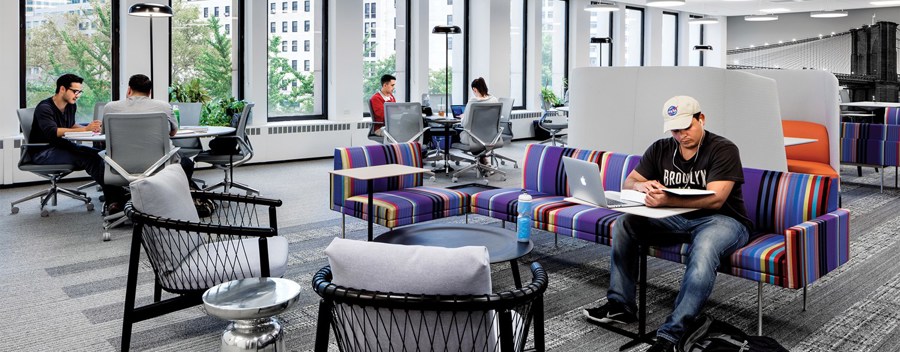
Library renovations are meeting the changing needs of a new generation of law students
By Kaitlin Ugolik Phillips
Traditionally bound by books and physical archives, legal work and education are being disrupted by technology along with every other industry and area of expertise, but the library is still central to the lives of law students, lawyers, and legal scholars. In fact, the library is as essential to today’s law students as it was in the early years of the Law School more than a century ago when the telephone was the latest technology. To keep up with changing needs and expectations of law students, the library recently underwent a renovation, including a new collaborative work space on the third floor and a new suite of offices for the Law School’s journals, which previously were housed at One Boerum Place.
Library Director Janet Sinder has been working in law librariesedusince 1985 and at Brooklyn Law School since 2012. She said that although there is less need now to visit the physical library to conduct research, students still flock there in search of a quiet place to study. But many are also looking for a place to meet and work with others. The new third-floor reading room has been designed to be more comfortable and inviting, with plenty of couches, chairs, and tables. On a recent afternoon, dozens of students sat studying at the circular tables or working together in the booth-style seating. Around the perimeter of the room, the four reference librarians—Kathy Darvil, Harold O’Grady, Loreen Peritz, and Eric Yap—have offices where students and others conducting research can easily access their expertise.
Scholarly Research in a Digital World
Sinder points to the library’s robust research resources, both online and off, as indispensable to students and faculty at the Law School as well as to lawyers and legal scholars around the world. Although databases such as Westlaw and LexisNexis are available to students and faculty from anywhere, library users also still rely heavily on real people.
The digital age has not lessened faculty members’ need for library resources or expertise. “In one sense, I’m using the library now more than ever before,” said Professor Aaron Twerski, who has taught at the Law School for more than 30 years. “When I was doing traditional case law analysis, I knew my way around very well, but when there are huge amounts of material I need the librarians.”
He is currently working on a new project that requires sifting through a caseload of more than 15,000 cases, which he said would be impossible to do without the librarians’ data and organizational savvy.
“As far as books are concerned, they’re a secondary matter. But I need expertise,” he said.
“The basics of what we do is getting the right information to the right people at the right time,” said Sinder, who was granted tenure this spring. This can mean subscribing to Westlaw, answering questions via email or instant message, or working with researchers one-on-one to determine the best strategy for accomplishing their goals.
A New Home for Journals in the Library
The summer renovations also include new individual offices and common space on floors 2 and 2M of the library for the Law School’s four journals, a boon for student writers and editors.
When Anne Conroy ’18 joined the Brooklyn Law Review in 2016, she began making frequent visits to the library to pull cited books and official reports from the stacks to confirm publication details and quotations. While writing and editing a note about the effect of publicized data hacks on attorney-client privilege, she spent many hours sitting in the library doing research, asking the reference librarians for help refining search terms, and editing the many iterations of her work. Physical sources are still a big part of legal research, and Conroy—now editor-in-chief of the Law Review—is excited that her team has a new dedicated space for their work in the library.
The journal offices were previously housed across the street from the Law School, at One Boerum Place, in small rooms that could sometimes be less than inviting and that did not provide enough individual space for each journal. Now, Conroy and other students will be able to conduct their work in a more professional, productive atmosphere.
“The office is used for tasks ranging from printing sources to bouncing note topics around with fellow members,” she said. “Having this new space will provide more room for the senior and junior staff to interact with and get to know one another. So much of law school is solitary, but being on Law Review provides students with the opportunity to produce quality, cutting-edge legal scholarship as a team.”